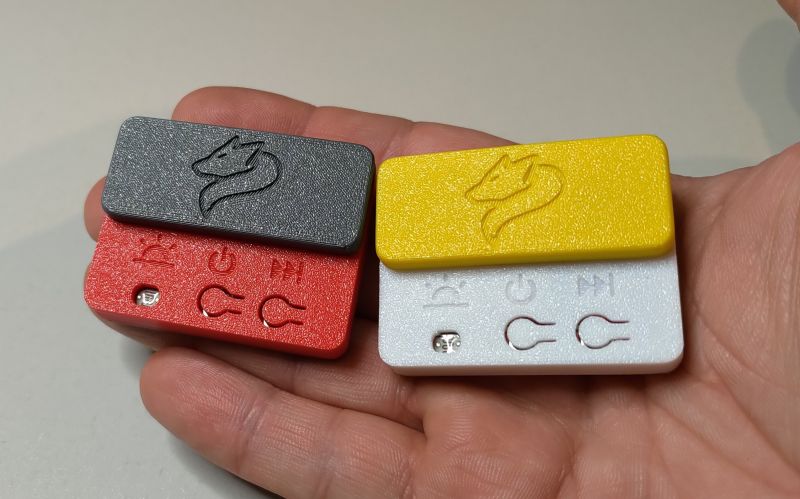Pigeon is a simple webcam, dedicated to work in the cloud. It is based on the Raspberry Pi Zero W, costing just $ 10. The minicomputer, together with the camera, are enclosed in a housing made in 3D printing technology. A simple handle is integrated with the housing, which allows it to be mounted anywhere, e.g. on the wall.
The software itself, listed below, should also work with, for example, a normal Raspberry Pi, although the 3D housing was designed for the Zero W model.
The aim of the project is to create a simple and inexpensive webcam with great possibilities and many functions that would work in the cloud.
Main functions
* Motion detection.
* Dropbox integration (for storing MP4 files recorded upon motion detection).
* Simple installer.
* Live video streaming to any web browser.
* Authentication when watching a video stream.
* Housing made in 3D printing technology.
* Possibility of interfacing with IFTTT (If this then that - a cloud-based system that allows you to control the behavior of the systems, managed via the web interface) - it allows, for example, to generate notifications: SMS, e-mail, slack messages, etc. when the camera detects motion, saves something in Dropbox etc.
* Automatic deletion of local files after uploading them to Dropbox.
* Integrated, modular design, making it easy to add new modules.
Needed items
* Printed cover - downloadable here .
* Raspberry Pi Zero W with the latest Raspbian (regular Zero, without WiFi module also works, but requires an additional wireless USB network card).
* Internet connection.
* Raspberry Pi Camera.
* 5V power supply with microUSB.
Installing the software
Let's connect to our Raspberry Pi Zero computer via SSH or connect the monitor and keyboard to it. We have to make sure that the camera connected to RPi is properly installed and working. To do this, enter in the command line:
If the camera does not work properly, we must make sure that it is enabled in the system (option number five in raspi-config):
In case of problems, help can be found, among others here .
Then we need to clone the repository, preferably using git, to our computer. In the console, enter:
After downloading the files, we need to give the script execution rights and run it:
Installing the software takes approximately 10 to 15 minutes. During this process, we will have to provide a number of data, including configuration of our Dropbox, etc.
Camera activation
After the installation is complete, just go to the website to watch the live video:
8099 is the default port for which the camera is configured. If we want to watch the video outside our local network, remember to configure port forwarding in our router.
If we want the camera application to start every time the system starts, we have to edit the rc.local file:
We add the following line in it:
ensuring however that the exit 0 line is at the end of the file. We add our entry right under the comment. After editing, save the file and exit the editor.
Finally, it is worth making sure that the right time zone in our RPi is set so that the files sent by the camera have the correct date and time. Just type in the command line:
And choose options: Internationalization Options, where we can find the time zone settings.
The current stage of project development
The project is currently in the initial stage of development. In pigeon.conf, you can change the default settings to suit your needs. Future ideas for device development include:
Software:
* Creation of a web interface for system management
* Remote access to the camera without port forwarding
* IOS app with push notifications
Hardware:
* LED lights on when motion is detected
* Servo to rotate the camera.
The first attempts to detect traffic are very promising. In the photo below we see an image with the detected moving object - a squirrel selected:
Sources:
https://www.thingiverse.com/thing:2230707
https://github.com/geraldoramos/pigeon
The software itself, listed below, should also work with, for example, a normal Raspberry Pi, although the 3D housing was designed for the Zero W model.
The aim of the project is to create a simple and inexpensive webcam with great possibilities and many functions that would work in the cloud.
Main functions
* Motion detection.
* Dropbox integration (for storing MP4 files recorded upon motion detection).
* Simple installer.
* Live video streaming to any web browser.
* Authentication when watching a video stream.
* Housing made in 3D printing technology.
* Possibility of interfacing with IFTTT (If this then that - a cloud-based system that allows you to control the behavior of the systems, managed via the web interface) - it allows, for example, to generate notifications: SMS, e-mail, slack messages, etc. when the camera detects motion, saves something in Dropbox etc.
* Automatic deletion of local files after uploading them to Dropbox.
* Integrated, modular design, making it easy to add new modules.
Needed items
* Printed cover - downloadable here .
* Raspberry Pi Zero W with the latest Raspbian (regular Zero, without WiFi module also works, but requires an additional wireless USB network card).
* Internet connection.
* Raspberry Pi Camera.
* 5V power supply with microUSB.
Installing the software
Let's connect to our Raspberry Pi Zero computer via SSH or connect the monitor and keyboard to it. We have to make sure that the camera connected to RPi is properly installed and working. To do this, enter in the command line:
Code: Bash
If the camera does not work properly, we must make sure that it is enabled in the system (option number five in raspi-config):
Code: Bash
In case of problems, help can be found, among others here .
Then we need to clone the repository, preferably using git, to our computer. In the console, enter:
Code: Bash
After downloading the files, we need to give the script execution rights and run it:
Code: Bash
Installing the software takes approximately 10 to 15 minutes. During this process, we will have to provide a number of data, including configuration of our Dropbox, etc.
Camera activation
ADVERTISEMENT
After the installation is complete, just go to the website to watch the live video:
http://[IP-NASZEJ-RPI]:[8099]8099 is the default port for which the camera is configured. If we want to watch the video outside our local network, remember to configure port forwarding in our router.
If we want the camera application to start every time the system starts, we have to edit the rc.local file:
Code: Bash
We add the following line in it:
Code: Bash
ensuring however that the exit 0 line is at the end of the file. We add our entry right under the comment. After editing, save the file and exit the editor.
Finally, it is worth making sure that the right time zone in our RPi is set so that the files sent by the camera have the correct date and time. Just type in the command line:
Code: Bash
And choose options: Internationalization Options, where we can find the time zone settings.
The current stage of project development
The project is currently in the initial stage of development. In pigeon.conf, you can change the default settings to suit your needs. Future ideas for device development include:
Software:
* Creation of a web interface for system management
* Remote access to the camera without port forwarding
* IOS app with push notifications
Hardware:
* LED lights on when motion is detected
* Servo to rotate the camera.
The first attempts to detect traffic are very promising. In the photo below we see an image with the detected moving object - a squirrel selected:
Sources:
https://www.thingiverse.com/thing:2230707
https://github.com/geraldoramos/pigeon
Cool? Ranking DIY






